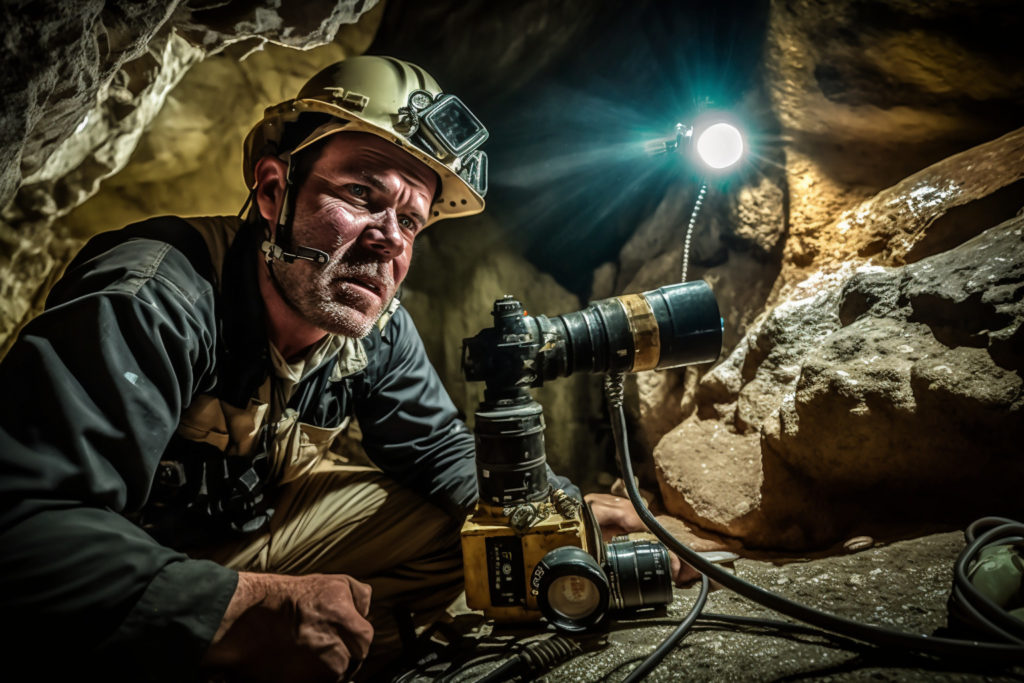Introduction to the Future of Mining
The Mining Industry has seen significant growth over the past year, with the market reaching $2145.15 billion in 2023, a CAGR of 6.1% since 2022.
According to the World Bank, the mining industry accounts for approximately 10% of the world’s GDP, making it a significant contributor to the global economy. The mining industry encompasses a wide range of activities, including the extraction of coal, iron ore, precious metals, and rare earth elements, among others. With advancements in technology and a growing global population, the demand for these resources is expected to increase in the coming years.
However, the future of mining is not without its challenges. Regulations and environmental concerns have a significant impact on the industry, affecting production, costs, and growth. In addition, the industry is constantly striving to improve safety measures for workers in the mines. To stay competitive, companies in the mining industry must stay up-to-date with the latest technology and advancements in safety measures.
In this article, we will provide a market report on the current state and future projections of the mining industry, as well as examine the latest advancements in mining technology. We will also discuss the importance of mining safety and the measures being taken to ensure the well-being of workers in the industry. Our goal is to provide finance professionals and market researchers with the latest insights and analysis to help them make informed decisions about investments in the mining industry.
Market Report for the Mining Industry
A. Current Market Status of the Mining Industry
The global mining industry is currently experiencing growth, with the industry expected to reach a value of $1.83 trillion by 2023. This growth is driven by increased demand for minerals and other resources for construction, manufacturing, and technology, as well as a growing global population.
The use of Mining Technology is also expected to play a crucial role in the industry’s growth. The incorporation of advanced technology such as automation, artificial intelligence, and data analytics will increase efficiency, productivity, and safety in the mining process. With the increasing demand for mineral resources, technology will play a crucial role in ensuring the sustainability and competitiveness of the industry in the future. The development and implementation of new mining technologies will also create opportunities for innovation and growth in the industry.
Ensuring the Safety of miners is also a crucial aspect of the industry. The use of technology can also improve safety in the mining industry by monitoring conditions, predicting potential hazards, and implementing preventative measures. Governments and industry leaders must prioritize the health and safety of workers in the mining industry and invest in the development of new safety technologies and training programs. This will not only benefit workers, but also increase the efficiency and competitiveness of the industry in the long term.
B. Future Projections for the Mining Industry
The future of the mining industry is promising, with many experts projecting steady growth in the coming years. According to a report from Research and Markets, the global mining industry is expected to grow at a compound annual growth rate (CAGR) of 6.7% from 2023 to 2027. This growth will be driven by increasing demand for minerals, rising commodity prices, and ongoing technological advancements in the industry.
The industry is expected to continue its growth trajectory, reaching $2775.5 billion in 2027 with a CAGR of 6.7%. Governments are playing a significant role in driving the market forward by providing subsidies and encouraging foreign direct investment through public finance institutions and state-owned mining companies. For example, the Government of India enacted the Mines and Minerals Amendment Act 2021 and published The Mineral Conservation and Development Rules to regulate and facilitate the growth of the industry in India. However, the shift towards alternative sources for power generation such as natural gas, nuclear power, and renewable energy is expected to act as a restraint on the demand for coal and thus the mining market.
C. Factors Affecting the Growth of the Mining Industry
Despite the overall positive outlook for the mining industry, there are several factors that may affect its growth. One of the biggest challenges facing the industry is the increasing regulations and environmental concerns surrounding the extraction of minerals and other resources. For example, the EU has implemented strict regulations on the use of certain chemicals in the mining process, which has resulted in increased costs and reduced profits for some companies.
Additionally, the growing trend towards renewable energy and electric vehicles may also impact the demand for certain minerals, such as coal and oil. This shift towards sustainability is likely to continue in the coming years, which may result in changes to the mining industry landscape.
Despite these challenges, the mining industry is poised for growth, with many companies investing in new technology and safety measures to remain competitive and meet the demands of a changing market.

Advancements in Mining Technology
Overview of current mining technology and its impact on the industry
The mining industry has undergone significant technological advancements in recent years, greatly improving the efficiency and productivity of mining operations. One major advancement has been the integration of automation technology, such as autonomous trucks and drills, into mining processes. For example, Rio Tinto, a leading mining company, has been at the forefront of this trend, utilizing autonomous trucks and drills to increase productivity and reduce operational costs.
Emerging technologies in the mining industry
The use of artificial intelligence (AI) in the mining industry is also on the rise, with companies using AI to optimize operations, enhance safety and reduce environmental impact. For example, BHP, another major mining company, is utilizing AI and machine learning to optimize blast design and reduce waste, improving the overall efficiency of their operations.
Benefits of implementing new mining technology
The implementation of new mining technology has numerous benefits, including increased efficiency, safety, and environmental sustainability. For instance, the use of autonomous equipment in mining operations reduces the need for human labor, improving safety in hazardous mining environments. In addition, the integration of AI and other technology into mining processes can help to reduce waste and minimize environmental impact, while also improving the overall efficiency and profitability of operations.
As the mining industry continues to evolve, it is clear that technology will play a crucial role in shaping its future. Companies that embrace and invest in new technologies will likely reap significant benefits, including increased efficiency, safety, and profitability. On the other hand, those that fail to keep pace with technological advancements may struggle to remain competitive in an increasingly technology-driven industry.
Importance of Mining Safety
The mining industry has always been a dangerous work environment, with miners facing a range of hazards on a daily basis. In recent years, however, there have been major advancements in mining safety technology, leading to a significant decrease in accidents and fatalities. But despite these advancements, it is still imperative for the industry to continue to prioritize and invest in safety measures to ensure the well-being of its workers.
A. Overview of Current Safety Measures in the Mining Industry
Today, many mining companies have implemented strict safety protocols, such as regular safety inspections, training programs for workers, and emergency response plans. These measures have significantly reduced the number of accidents in the industry, but there is always room for improvement. For example, in 2022, the National Institute for Occupational Safety and Health (NIOSH) reported that the fatal injury rate in the mining industry was 10.2 per 100,000 full-time equivalent workers, which is higher than the rate for all U.S. industries.
B. Emerging Safety Technologies
To further improve the safety of miners, new technologies are being developed and implemented in the industry. For example, wearable safety devices, such as smart helmets equipped with sensors and cameras, can provide real-time monitoring and alerts in hazardous situations. Remote monitoring systems can also be used to track the location of miners and ensure their safety in the event of an emergency.
Another promising technology is autonomous mining, which involves using self-driving vehicles and machines to perform mining tasks. This not only increases efficiency, but also reduces the risk of accidents and injuries to workers, as human intervention is minimized. For instance, Rio Tinto, one of the largest mining companies in the world, has successfully implemented autonomous trucks and drills in its operations.
C. The Role of Government and Industry Leaders in Mining Safety Measures
In addition to new technologies, government regulations and industry standards also play a crucial role in promoting and maintaining safety in the mining industry. Governments can enforce safety regulations, such as mandating the use of certain technologies, and industry leaders can set the standard by investing in and implementing these technologies in their operations.
For example, the Mine Safety and Health Administration (MSHA), a U.S. government agency, has implemented regulations requiring the use of proximity detection systems on certain types of mining equipment to prevent accidents involving workers and mobile equipment. Industry leaders, such as BHP, have also made significant investments in safety technology and initiatives to create a safer work environment for their employees.
In conclusion, the importance of mining safety cannot be overstated. With continued advancements in technology and a commitment from both government and industry leaders, the mining industry can continue to prioritize the safety and well-being of its workers and strive towards a safer future.
V. Conclusion
The mining industry plays a crucial role in the global economy, and its growth and prosperity are intertwined with advancements in technology and safety measures. In recent years, the industry has seen significant technological advancements, such as automation and artificial intelligence, that have increased efficiency and safety in mines. However, the industry also faces challenges, such as regulations and environmental concerns, that must be addressed for it to continue to thrive.
In this article, we have examined the current market status of the mining industry, future projections, and the impact of technology and safety on growth and profitability. Our findings show that the mining industry is poised for significant growth in the coming years, driven by advancements in technology and a continued focus on safety measures.
Despite the challenges that the industry faces, we are confident in the future of mining and the positive impact it will have on the global economy. The implementation of new technologies and safety measures will not only make mining operations more efficient and secure, but it will also pave the way for the industry’s continued growth and success.
Sources:
- Mining Industry Report, IBISWorld
- The Big Potential of Mining: Five Initiatives, McKinsey & Company
- The Future of Mining: Five Technological Innovations to Watch, Mining Technology
- Improving Mining Safety and Health, World Bank
We hope you have found this report on Mining, Mining Industry, Mining Technology, and Mining Safety informative and useful. If you’re interested in staying up to date with the latest trends and developments in various industries, we encourage you to check out our other reports. From investing in infrastructure to the impact of artificial intelligence on industry growth, our reports provide in-depth insights and analysis for finance professionals and investors. Additionally, our reports on sustainable manufacturing, the future of the oil and gas industry, and the potential of drones offer valuable information on industries related to Mining.











